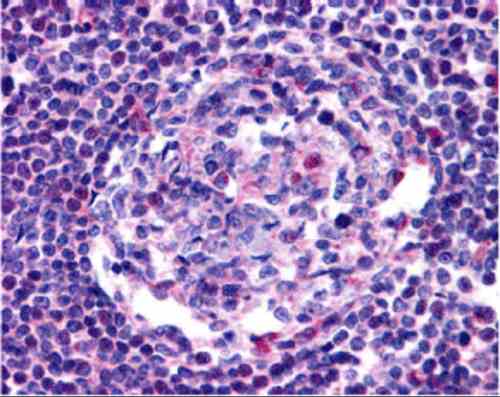| Weight | 1 lbs |
|---|---|
| Dimensions | 9 × 5 × 2 in |
| host | rabbit |
| isotype | IgG |
| clonality | polyclonal |
| concentration | 1 mg/mL |
| applications | ICC/IF, WB |
| reactivity | CCR5 (NT) |
| available sizes | 100 µg |
rabbit anti-CCR5 (NT) polyclonal antibody 8869
$445.00
Antibody summary
- Rabbit polyclonal to CCR5 (NT)
- Suitable for: ELISA,WB,IHC-P,IF
- Isotype: IgG
- 100 µg
rabbit anti-CCR5 (NT) polyclonal antibody 8869
| antibody |
|---|
| Tested applications WB,IHC,IHC,ICC/IF,ELISA |
| Recommended dilutions Immunoblotting: use at 1:1,000-1:2,000 dilution. Positive control: Whole cell lysate from THP-1 cells. |
| Immunogen Peptide corresponding to aa 6-20 of human CCR5. |
| Size and concentration 100µg and lot specific |
| Form liquid |
| Storage Instructions This antibody is stable for at least one (1) year at -20°C. Avoid multiple freeze- thaw cycles. |
| Storage buffer PBS, pH 7.4. |
| Purity peptide affinity purification |
| Clonality polyclonal |
| Isotype IgG |
| Compatible secondaries goat anti-rabbit IgG, H&L chain specific, peroxidase conjugated, conjugated polyclonal antibody 9512 goat anti-rabbit IgG, H&L chain specific, biotin conjugated polyclonal antibody 2079 goat anti-rabbit IgG, H&L chain specific, FITC conjugated polyclonal antibody 7863 goat anti-rabbit IgG, H&L chain specific, Cross Absorbed polyclonal antibody 2371 goat anti-rabbit IgG, H&L chain specific, biotin conjugated polyclonal antibody, crossabsorbed 1715 goat anti-rabbit IgG, H&L chain specific, FITC conjugated polyclonal antibody, crossabsorbed 1720 |
| Isotype control Rabbit polyclonal - Isotype Control |
| target relevance |
|---|
| Protein names C-C chemokine receptor type 5 (C-C CKR-5) (CC-CKR-5) (CCR-5) (CCR5) (CHEMR13) (HIV-1 fusion coreceptor) (CD antigen CD195) |
| Gene names CCR5,CCR5 CMKBR5 |
| Protein family G-protein coupled receptor 1 family |
| Mass 40524Da |
| Function FUNCTION: Receptor for a number of inflammatory CC-chemokines including CCL3/MIP-1-alpha, CCL4/MIP-1-beta and RANTES and subsequently transduces a signal by increasing the intracellular calcium ion level. May play a role in the control of granulocytic lineage proliferation or differentiation. Participates in T-lymphocyte migration to the infection site by acting as a chemotactic receptor (PubMed:30713770). {ECO:0000269|PubMed:10383387, ECO:0000269|PubMed:11323418, ECO:0000269|PubMed:30713770, ECO:0000269|PubMed:8639485, ECO:0000269|PubMed:8663314, ECO:0000269|PubMed:8699119}.; FUNCTION: (Microbial infection) Acts as a coreceptor (CD4 being the primary receptor) of human immunodeficiency virus-1/HIV-1. {ECO:0000269|PubMed:10383387, ECO:0000269|PubMed:21763489, ECO:0000269|PubMed:8649511, ECO:0000269|PubMed:8649512, ECO:0000269|PubMed:9632396}. |
| Subellular location SUBCELLULAR LOCATION: Cell membrane {ECO:0000269|PubMed:10383387, ECO:0000269|PubMed:11323418}; Multi-pass membrane protein {ECO:0000269|PubMed:11323418}. |
| Tissues TISSUE SPECIFICITY: Highly expressed in spleen, thymus, in the myeloid cell line THP-1, in the promyeloblastic cell line KG-1a and on CD4+ and CD8+ T-cells. Medium levels in peripheral blood leukocytes and in small intestine. Low levels in ovary and lung. {ECO:0000269|PubMed:8639485, ECO:0000269|PubMed:8663314}. |
| Structure SUBUNIT: Interacts with PRAF2 (PubMed:15757671). Efficient ligand binding to CCL3/MIP-1alpha and CCL4/MIP-1beta requires sulfation, O-glycosylation and sialic acid modifications. Glycosylation on Ser-6 is required for efficient binding of CCL4 (PubMed:10383387, PubMed:11733580, PubMed:8663314, PubMed:8699119). Interacts with GRK2 (PubMed:10085131). Interacts with ARRB1 and ARRB2 (PubMed:11448957, PubMed:16144840). Interacts with CNIH4 (PubMed:24405750). Interacts with S100A4; this interaction stimulates T-lymphocyte chemotaxis (PubMed:30713770). {ECO:0000269|PubMed:10085131, ECO:0000269|PubMed:10383387, ECO:0000269|PubMed:11448957, ECO:0000269|PubMed:11733580, ECO:0000269|PubMed:15757671, ECO:0000269|PubMed:16144840, ECO:0000269|PubMed:24405750, ECO:0000269|PubMed:30713770, ECO:0000269|PubMed:8663314, ECO:0000269|PubMed:8699119}.; SUBUNIT: (Microbial infection) Interacts with HIV-1 surface protein gp120. {ECO:0000269|PubMed:21763489, ECO:0000269|PubMed:9632396}.; SUBUNIT: (Microbial infection) May interact with human cytomegalovirus/HHV-5 protein UL78. {ECO:0000269|PubMed:22496149}. |
| Post-translational modification PTM: Sulfated on at least 2 of the N-terminal tyrosines. Sulfation contributes to the efficiency of HIV-1 entry and is required for efficient binding of the chemokines, CCL3 and CCL4. {ECO:0000269|PubMed:10089882, ECO:0000269|PubMed:11733580, ECO:0000269|PubMed:21763489}.; PTM: O-glycosylated, but not N-glycosylated. Ser-6 appears to be the major site even if Ser-7 may be also O-glycosylated. Also sialylated glycans present which contribute to chemokine binding. Thr-16 and Ser-17 may also be glycosylated and, if so, with small moieties such as a T-antigen. {ECO:0000269|PubMed:10089882, ECO:0000269|PubMed:11733580}.; PTM: Palmitoylation in the C-terminal is important for cell surface expression, and to a lesser extent, for HIV entry. {ECO:0000269|PubMed:11323418}.; PTM: Phosphorylation on serine residues in the C-terminal is stimulated by binding CC chemokines especially by APO-RANTES. {ECO:0000269|PubMed:10085131}. |
| Involvement in disease DISEASE: Type 1 diabetes mellitus 22 (T1D22) [MIM:612522]: A multifactorial disorder of glucose homeostasis that is characterized by susceptibility to ketoacidosis in the absence of insulin therapy. Clinical features are polydipsia, polyphagia and polyuria which result from hyperglycemia-induced osmotic diuresis and secondary thirst. These derangements result in long-term complications that affect the eyes, kidneys, nerves, and blood vessels. {ECO:0000269|PubMed:19073967}. Note=Disease susceptibility is associated with variants affecting the gene represented in this entry. |
| Target Relevance information above includes information from UniProt accession: P51681 |
| The UniProt Consortium |
Data
Publications
| pmid | title | authors | citation |
|---|---|---|---|
| We haven't added any publications to our database yet. | |||
Protocols
| relevant to this product |
|---|
| Western blot IHC ICC |
Documents
| # | SDS | Certificate | |
|---|---|---|---|
| Please enter your product and batch number here to retrieve product datasheet, SDS, and QC information. | |||
Only logged in customers who have purchased this product may leave a review.















Reviews
There are no reviews yet.